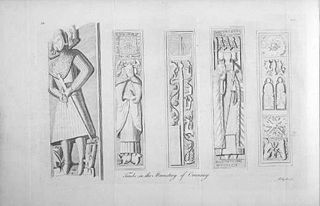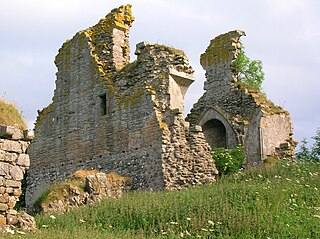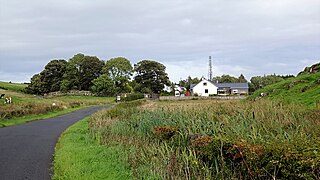Related Research Articles
Colin Campbell, 6th Earl of Argyll was a Scottish nobleman and politician. He was appointed to the Lord Chancellorship of Scotland.

The Archdiocese of Saint Andrews & Edinburgh is an archdiocese of the Latin Church of the Roman Catholic Church in Scotland. It is the Metropolitan see of the Province of Saint Andrews and Edinburgh, consisting of the additional suffragan sees of Aberdeen, Argyll and the Isles, Dunkeld, and Galloway. The archdiocese is led by Archbishop Leo Cushley.

Sir Thomas Craig of Riccarton was a Scottish jurist and poet.

The Clan Wallace is a Lowlands Scottish Clan and is officially recognized as such by the Lord Lyon King of Arms. The most famous member of the clan was the Scottish patriot William Wallace of the late 13th and early 14th centuries.

Robert Blair was a Scottish presbyterian minister who became a Westminster Divine and Moderator of the General Assembly of the Church of Scotland in 1646, after failing to emigrate to Boston in 1636. Born in Irvine in 1593, the sixth son of John Blair of Windyedge, a merchant-adventurer and cadet of Blair, and Beatrix Mure of the Rowallan family, he gained an MA at the University of Glasgow in 1612 and became regent there in 1615. When the episcopalian John Cameron was appointed Principal, Blair resigned and went to Ireland, to become minister of a Presbyterian congregation at Bangor, County Down. He was ordained for it by Robert Echlin, Bishop of Down and Connor, Blair was "very careful to inform... of what accusations had been laid against me of disaffection to the civil powers, whom he was the use of the English liturgy nor Episcopal government.... I declared my opinion fully to the Bishop at our first meeting... [who] said to me, 'I hear good of you, and will impose no conditions on you.'" Echlin, however, turned against him. In September 1631, he was suspended from his ministry and on 4 May 1632 deposed. Though bent on emigrating to New England, the ship in which he and other ministers sailed was driven back by weather, a sign, Blair thought, that his services were still required at home. He dodged an order for his arrest by escaping to Scotland and was admitted to the Second Charge of Ayr in July 1638. After periods in Scotland and Ireland, he accompanied the Scottish army to England in 1640 and helped to negotiate the 1641 Peace of Ripon. In 1646, Blair was elected Moderator of General Assembly, then Chaplain-in-Ordinary to King Charles I. He was also on a committee endeavouring in 1648 to get Cromwell to establish "a uniformity of religion in England." He was summoned to London by Cromwell in 1654, but excused himself on grounds of ill-health. On the establishment of episcopacy he was removed from his charges in September 1661, confined to Musselburgh, then to Kirkcaldy for three and a half years, and then to Meikle Couston, Aberdour, Fife, where he died on 27 August 1666 and was buried.

John of Islay was the Lord of the Isles (1336–1386) and chief of Clan Donald. In 1336, he styled himself Dominus Insularum, "Lord of the Isles"; because this is the first ever recorded instance of the title in use, modern historians count John as the first of the later medieval Lords of the Isles, although this rather broad Latin style corresponds roughly with the older Gaelic title Rí Innse Gall, in use since the Viking Age, and for instance, the even more similar Latin title dominus de Inchegal, applied to Raghnall Mac Somhairle in the mid-12th century. In fact John is actually styled Rí Innsi Gall or King of the Isles shortly after his death in a contemporary entry in the Irish Annals of Ulster.

James Law was Archbishop of Glasgow. Entering the church after graduation from university, he rose to the position of Bishop of Orkney, reorganising the diocese, before rising to hold the position of Archbishop of Glasgow.

Riccarton is a village and parish in East Ayrshire, Scotland. It lies across the River Irvine from Kilmarnock, this river forming the boundary between Riccarton and Kilmarnock parishes, and also between the historical districts of Kyle and Cunningham. The name is a corruption of 'Richard's town', traditionally said to refer to Richard Wallace, the uncle of Sir William Wallace. The parish also contains the village of Hurlford.

Craigie Castle, in the old Barony of Craigie, is a ruined fortification situated about 4 miles (6.4 km) southeast of Kilmarnock and 1 mile (1.6 km) southeast of Craigie village, in the Civil Parish of Craigie, South Ayrshire, Scotland. The castle is recognised as one of the earliest buildings in the county. It lies about 1.25 miles (2 km) west-south-west of Craigie church. Craigie Castle is protected as a scheduled monument.
Hugh Montgomerie, 1st Earl of Eglinton was a Scottish peer.

Barnweill Church or Barnweil Church is a ruined pre-reformation kirk situated on rising ground on the slopes of Barnweill Hill, Parish of Craigie, South Ayrshire, Scotland; about 3 km from Tarbolton. The church was known locally as the "Kirk in the Wood". It lies about 170m North North-East of Kirkhill Farm. Barnweill was central to the Protestant Reformation in Ayrshire through its association with John Knox. The spelling 'Barnweill' is used throughout for consistency.

William Baillie, Lord Polkemmet was a Scottish law lord.

The Barony of Craigie is a Scottish feudal Crown barony within and near Dundee in Scotland. Craigie has long been incorporated within the boundaries of the Royal Burgh of Dundee; before that it was a barony lying on the periphery of the town.

The remains of the old castle of Kersland lie about 1.5 miles to the north-east of the town of Dalry in North Ayrshire, Scotland, in the old Barony of Kersland. The River Garnock lies nearby.

Very Rev Dr Robert Wallace DD was a minister of the Church of Scotland and writer on population.
Alexander Montgomerie, 1st Lord Montgomerie was a Scottish nobleman and diplomat.

Craigie is a small village and parish of 6,579 acres in the old district of Kyle, now South Ayrshire, four miles south of Kilmarnock, Scotland. This is mainly a farming district, lacking in woodland, with a low population density, and only one village. In the 19th century, high quality lime was quarried here with at least three sites in use in 1832.

John Livingstone or Livingston was born in Kilsyth, on 21 June 1603. He was the son of William Livingstone, minister of Kilsyth, and afterwards of Lanark, said to be a descendant of the fifth Lord Livingston. His mother was Agnes, daughter of Alexander Livingston, portioner, Falkirk, brother of the Laird of Belstane.
William Wallace of Failford,, was a Scottish courtier and landowner.

David Williamson was a Scottish minister and Covenanter who served as moderator of the General Assembly of the Church of Scotland in 1702. He is notable for his long association with Edinburgh's West Kirk, his seven marriages, and his portrayal in the traditional song "Dainty Davie".